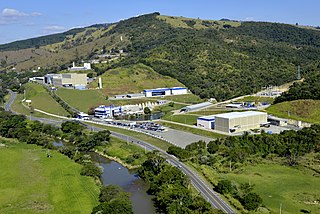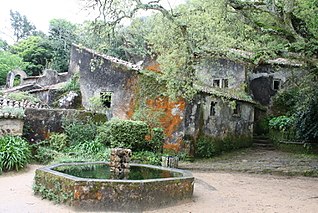
Sintra is a town and municipality in the Greater Lisbon region of Portugal, located on the Portuguese Riviera. The population of the municipality in 2021 was 385,654, in an area of 319.23 square kilometres (123.26 sq mi). Sintra is one of the most urbanized and densely populated municipalities of Portugal. A major tourist destination famed for its picturesqueness, the municipality has several historic palaces, castles, scenic beaches, parks and gardens.
São Pedro, Portuguese for Saint Peter, may refer to the following places:

Itapira is a municipality in the state of São Paulo in Brazil. The population is 75,234 in an area of 518 km². The elevation is 643 m.
São Martinho may refer to the following places:
Alcantara, Alcântara (Portuguese), Alcántara (Spanish), Alcàntara, Alcàntera, El-Qantarah and (El) Kantara are all transliterations of the Arabic word al-qantara (القنطرة), meaning "the bridge".
Pedro de Sintra, also known as Pero de Sintra, Pedro da Cintra or Pedro da Sintra, was a Portuguese explorer. He was among the first Europeans to explore the West African coast. Around 1462 his expedition reached what is now Sierra Leone and named it. Although according to professor C. Magbaily Fyle this could have possibly been a misinterpretation of historians; there has been evidence of Serra Lyoa being mentioned prior to 1462, the year when de Sintra's expedition reached the coast of Sierra Leone. This would suggest that the person who named Sierra Leone is still unknown. However, if de Sintra did name the area, it is unclear whether he named it after the landforms or climate in the area. According to some the coastal regions resembled lion's teeth while others suggest the thunderstorms sounded like the roar of a lion. Sixteenth century English sailors called the area Sierra Leoa which later evolved to Sierra Leone in the 17th century. The British, prior to the area being colonised, officially adopted the name Sierra Leone in 1787.
São Pedro de Penaferrim is a former civil parish in the municipality of Sintra, Lisbon District, Portugal. In 2013, the parish merged into the new parish Sintra. The population in 2011 was 14,001, in an area of 26.97 km2. Many of the town of Sintra's historical monuments are located in São Pedro de Penaferrim, including the Pena Palace and the Castle of the Moors.
Cintra is an international operator of toll roads and car parks.
Gonçalo de Sintra or de Cintra (d.1444/45), was a 15th-century Portuguese explorer and servant of Prince Henry the Navigator.

The Convent of the Friars Minor Capuchin, popularly known as the Convent of the Capuchos, but officially the Convento de Santa Cruz da Serra da Sintra, is a historical convent consisting of small quarters and public spaces located in the civil parish of São Pedro de Penaferrim, in Sintra Municipality, Portugal. Its creation was associated with the Portuguese Viceroy of India, D. João de Castro, and his family, but became a pious community of reclusive clergy that continued to occupy cramped humble spaces in the complex until the religious orders were abolished in Portugal.

The Roman Bridge of Catribana is located near the village of Catribana in the parish of São João das Lampas, in the municipality of Sintra in the Lisbon District of Portugal. Not being identified as a Roman bridge until the 1980s, and having suffered considerable degradation, it was restored in 2019.

The Castle of the Moors is a hilltop medieval castle located in the central Portuguese civil parish of Santa Maria e São Miguel, in the municipality of Sintra, about 25 km (16 mi) northwest of Lisbon. Built by the Moors in the 8th and 9th centuries, it was an important strategic point during the Reconquista, and was taken by Christian forces after the fall of Lisbon in 1147. It is classified as a National Monument, part of the Sintra Cultural Landscape, a UNESCO World Heritage Site.
Sintra is a civil parish in the municipality of Sintra, Lisbon District, Portugal. It was formed in 2013 by the merger of the former parishes Santa Maria e São Miguel, São Martinho and São Pedro de Penaferrim. The population in 2011 was 29,591, in an area of 63.55 km2.

Summer architecture was a Portuguese architectural movement originating in the Portuguese Riviera, in the late 19th and early 20th centuries, when the region became a popular resort destination for the Portuguese royal family and the Portuguese aristocracy. The movement is not characterized by any single architectural style or artistic school, but rather unified by common themes, including leisure, wellness, exoticism, and heterotopia.
This page is based on this
Wikipedia article Text is available under the
CC BY-SA 4.0 license; additional terms may apply.
Images, videos and audio are available under their respective licenses.





